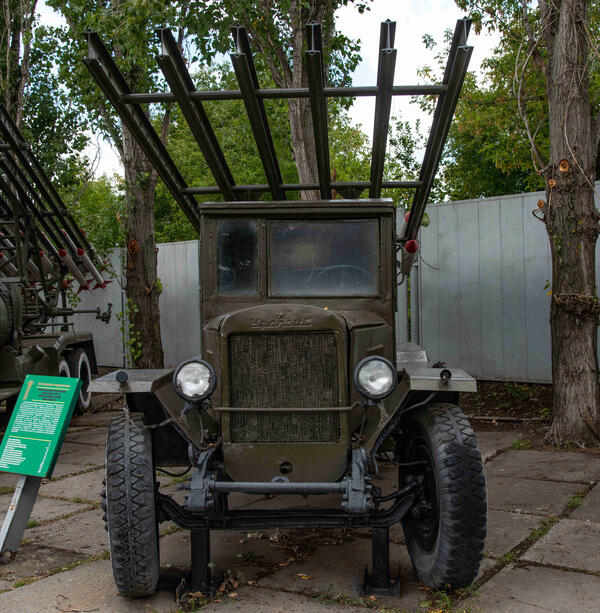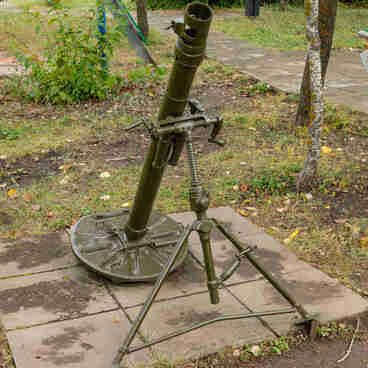The Katyusha — the BM-13 rocket artillery combat vehicle — was developed by a team of designers at the Jet Propulsion Research Institute in Moscow. It entered service in 1941.
The BM-13 was designed to fire 132mm rocket-powered high-explosive projectiles and was used to destroy enemy troops, combat vehicles and motorized infantry in the places of their concentration.
The launcher had great maneuverability and provided a high density of fire: it could fire 16 rounds within 7–10 seconds. The artillery system was produced at the Voronezh “Komintern” Mechanical Plant and at the Moscow “Compressor” Plant. It was mounted on the chassis of a ZIS-6 three-axle all-terrain vehicle.
On June 21, 1941, the truck-mounted multiple rocket launchers were demonstrated to the leaders of the Soviet government. It had been decided to urgently start serial production of the rockets and launchers just a few hours before the Great Patriotic War began.
Five days later, on June 26, 1941, the assembly of the first serial BM-13 launchers on the chassis of the ZIS-6 truck was completed. 16 launch rails were installed on the truck. In 8 to 10 seconds the system launched 1248 kg of explosives at a distance of up to 9 km.
On June 28, an experimental battery of rocket artillery was made up of seven combat vehicles under the command of Captain Ivan Andreyevich Flyorov. On July 14, 1941, the first salvo was fired at the enemy near the city of Orsha.
The fire accuracy of the BM-13 launchers was not the best, but they were very effective when used en masse. The launchers’ maneuverability made it possible to quickly change position and avoid enemy retaliatory strikes. Each vehicle stored a box with explosives and a Bickford fuse (a safety fuse). If there was a risk of capture by the enemy, the crew was to blow the vehicle up, thereby destroying the rocket launcher.
The battery of Ivan Andreyevich Flyorov successfully fought the Nazis until October 1941. On the night of October 7, 1941, the unit was ambushed. The crew and the commander were killed: they ran out of ammunition and then blew up their combat vehicles. Captain Flyorov was posthumously awarded the Order of the Patriotic War, 1st class.
The BM-13 was designed to fire 132mm rocket-powered high-explosive projectiles and was used to destroy enemy troops, combat vehicles and motorized infantry in the places of their concentration.
The launcher had great maneuverability and provided a high density of fire: it could fire 16 rounds within 7–10 seconds. The artillery system was produced at the Voronezh “Komintern” Mechanical Plant and at the Moscow “Compressor” Plant. It was mounted on the chassis of a ZIS-6 three-axle all-terrain vehicle.
On June 21, 1941, the truck-mounted multiple rocket launchers were demonstrated to the leaders of the Soviet government. It had been decided to urgently start serial production of the rockets and launchers just a few hours before the Great Patriotic War began.
Five days later, on June 26, 1941, the assembly of the first serial BM-13 launchers on the chassis of the ZIS-6 truck was completed. 16 launch rails were installed on the truck. In 8 to 10 seconds the system launched 1248 kg of explosives at a distance of up to 9 km.
On June 28, an experimental battery of rocket artillery was made up of seven combat vehicles under the command of Captain Ivan Andreyevich Flyorov. On July 14, 1941, the first salvo was fired at the enemy near the city of Orsha.
The fire accuracy of the BM-13 launchers was not the best, but they were very effective when used en masse. The launchers’ maneuverability made it possible to quickly change position and avoid enemy retaliatory strikes. Each vehicle stored a box with explosives and a Bickford fuse (a safety fuse). If there was a risk of capture by the enemy, the crew was to blow the vehicle up, thereby destroying the rocket launcher.
The battery of Ivan Andreyevich Flyorov successfully fought the Nazis until October 1941. On the night of October 7, 1941, the unit was ambushed. The crew and the commander were killed: they ran out of ammunition and then blew up their combat vehicles. Captain Flyorov was posthumously awarded the Order of the Patriotic War, 1st class.




